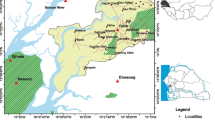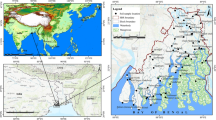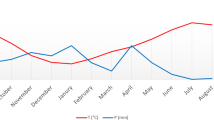Abstract
In the south of Fars Province in Iran, there are several closed basins where the salinity of water and soil resources is one of the main problems. Therefore, to manage the water and soil resources of these basins, identifying the source of salinity and its expansion in playa is necessary. Thus, the Izad-Khast pit in the south of Fars Province of Iran was selected as one of these basins for research. To achieve the goal, 16 soil samples were randomly taken from the basin, and their EC was determined. Landsat 8 image was selected according to sampling day, and ten salinity indices were extracted from it. Then, the best index was determined by the relationship between salinity indices and ground EC using linear regression. Using the determined index and linear equation derived from linear regression and Landsat 7 and 8 images, salinity maps were obtained in three periods 2010, 2015, and 2020. Then, using maps of the three mentioned intervals and the CA-Markov method, soil salinity prediction maps were extracted for 2025 and 2030. Based on the research results, salinity index S2 = (Blue − R)/(Blue + R) provided the best results. Salinity maps derived from this index show that the highest level is related to the area with no salinity or low salinity, and high degrees of salinity are concentrated in some parts of the hills and in some areas of the plain, respectively, which determines the origin of salts. The results also showed that the kappa coefficient of CA-Markov is 0.7282, which shows the high ability of the model to predict soil salinity, in which the distance factor from gypsum and salt minerals is the most critical predictor factor. According to the forecasts, from 2020 to 2025, about 1 km2 and then from 2025 to 2030, about 1.6 km2 will be added to the saline lands.








Similar content being viewed by others
Data availability
The datasets generated during and, or analyzed during the current study are available from the corresponding author upon reasonable request. Supplementary data associated with this article can be found, in the online version, at https://earthexplorer.usgs.gov/
References
Abbas, A., & Khan, S. (2007). Using remote sensing techniques for appraisal of irrigated soil salinity. Int. Congr. Model. Simul.(MODSIM), Model. Simul. Soc. Aust. New Zealand, Bright(January), 2632–2638.
Abdelgavad, G. (1992). Gypsiferous soil properties and management. The Arab center for the studies of arid zones and dry lands. Damascus, Syrian Arab Republic, 68p.
Adhikari, S., & Southworth, J. (2012). Simulating forest cover changes of Bannerghatta National Park based on a CA-Markov model: A remote sensing approach. Remote Sensing, 4(10), 3215–3243. https://doi.org/10.3390/rs4103215
Al-Hassoun, S. A. (2009). Remote sensing of soil salinity in an arid areas in Saudi Arabia. International Journal of Civil and Environmental Engineering.
Alavipanah, S., & Goossens, R. (2001). Relationship between the Landsat TM, MSS data and soil salinity.
Aldabaa, A. A. A., Weindorf, D. C., Chakraborty, S., Sharma, A., & Li, B. (2015). Combination of proximal and remote sensing methods for rapid soil salinity quantification. Geoderma, 239, 34–46. https://doi.org/10.1016/j.geoderma.2014.09.011
Bai, L., Wang, C., Zang, S., Zhang, Y., Hao, Q., & Wu, Y. (2016). Remote sensing of soil alkalinity and salinity in the Wuyu’er-Shuangyang River Basin, Northeast China. Remote Sensing, 8(2), 163. https://doi.org/10.3390/rs8020163
Bannari, A., Guedon, A., El-Harti, A., Cherkaoui, F., & El-Ghmari, A. (2008). Characterization of slightly and moderately saline and sodic soils in irrigated agricultural land using simulated data of advanced land imaging (EO-1) sensor. Communications in Soil Science and Plant Analysis, 39(19–20), 2795–2811. https://doi.org/10.1080/00103620802432717
Bishop, T., & McBratney, A. (2001). A comparison of prediction methods for the creation of field-extent soil property maps. Geoderma, 103(1–2), 149–160. https://doi.org/10.1016/S0016-7061(01)00074-X
Clay, D., Chang, J., Malo, D., Carlson, C., Reese, C., Clay, S., Ellsbury, M., & Berg, B. (2001). Factors influencing spatial variability of soil apparent electrical conductivity. Communications in Soil Science and Plant Analysis, 32(19–20), 2993–3008. https://doi.org/10.1081/CSS-120001102
Dehni, A., & Lounis, M. (2012). Remote sensing techniques for salt affected soil mapping: Application to the Oran region of Algeria. Procedia Engineering, 33, 188–198. https://doi.org/10.1016/j.proeng.2012.01.1193
Douaoui, A. E. K., Nicolas, H., & Walter, C. (2006). Detecting salinity hazards within a semiarid context by means of combining soil and remote-sensing data. Geoderma, 134(1–2), 217–230. https://doi.org/10.1016/j.geoderma.2005.10.009
Dwivedi, R. (1996). Monitoring of salt-affected soils of the Indo-Gangetic alluvial plains using principal component analysis. International Journal of Remote Sensing, 17(10), 1907–1914. https://doi.org/10.1080/01431169608948746
Farifteh, J. (2007). Imaging Spectroscopy of salt-affected soils: Model-based integrated method, Doctoral dissertation Utrecht University, ITC (Faculty of Geo-Information Science and Earth Observation, University of Twente) Dissertation 143. ISBN: 978–90–6164–259–6.
Fernandez-Buces, N., Siebe, C., Cram, S., & Palacio, J. (2006). Mapping soil salinity using a combined spectral response index for bare soil and vegetation: A case study in the former lake Texcoco, Mexico. Journal of Arid Environments, 65(4), 644–667. https://doi.org/10.1016/j.jaridenv.2005.08.005
Gabrijel, O., Davor, R., Zed, R., Marija, R., & Monika, Z. (2009). Cadmium accumulation by muskmelon under salt stress in contaminated organic soil. Science of the Total Environment, 407(7), 2175–2182. https://doi.org/10.1016/j.scitotenv.2008.12.032
Gorji, T., Sertel, E., & Tanik, A. (2017). Monitoring soil salinity via remote sensing technology under data scarce conditions: A case study from Turkey. Ecological Indicators, 74, 384–391. https://doi.org/10.1016/j.ecolind.2016.11.043
Gutierrez, M., & Johnson, E. (2010). Temporal variations of natural soil salinity in an arid environment using satellite images. Journal of South American Earth Sciences, 30(1), 46–57. https://doi.org/10.1016/j.jsames.2010.07.005
Hamad, R., Balzter, H., & Kolo, K. (2018). Predicting land use/land cover changes using a CA-Markov model under two different scenarios. Sustainability, 10(10), 3421. https://doi.org/10.3390/su10103421
Han, L., Liu, D., Cheng, G., Zhang, G., & Wang, L. (2019). Spatial distribution and genesis of salt on the saline playa at Qehan Lake, Inner Mongolia, China. CATENA, 177, 22–30. https://doi.org/10.1016/j.catena.2019.01.040
Hawkins, E., Fulton, J., & Port, K. (2017). Using soil electrical conductivity (EC) to delineate field variation. Agriculture and Natural Resources.
Hihi, S., Rabah, Z. B., Bouaziz, M., Chtourou, M. Y., & Bouaziz, S. (2019). Prediction of soil salinity using remote sensing tools and linear regression model. Advances in Remote Sensing, 8(3), 77–88. https://doi.org/10.4236/ars.2019.83005
Hoa, P. V., Giang, N. V., Binh, N. A., Hai, L. V. H., Pham, T. -D., Hasanlou, M., & Tien Bui, D. (2019). Soil salinity mapping using SAR sentinel-1 data and advanced machine learning algorithms: A case study at Ben Tre Province of the Mekong River Delta (Vietnam). Remote Sensing, 11(2), 128. https://doi.org/10.3390/rs11020128
Hyandye, C., & Martz, L. W. (2017). A Markovian and cellular automata land-use change predictive model of the Usangu Catchment. International Journal of Remote Sensing, 38(1), 64–81. https://doi.org/10.1080/01431161.2016.1259675
Kamusoko, C., Aniya, M., Adi, B., & Manjoro, M. (2009). Rural sustainability under threat in Zimbabwe–simulation of future land use/cover changes in the Bindura district based on the Markov-cellular automata model. Applied Geography, 29(3), 435–447. https://doi.org/10.1016/j.apgeog.2008.10.002
Khan, N. M., Rastoskuev, V. V., Sato, Y., & Shiozawa, S. (2005). Assessment of hydrosaline land degradation by using a simple approach of remote sensing indicators. Agricultural Water Management, 77(1–3), 96–109. https://doi.org/10.1016/j.agwat.2004.09.038
Li, P., Wu, J., & Qian, H. (2016). Regulation of secondary soil salinization in semi-arid regions: A simulation research in the Nanshantaizi area along the Silk Road, northwest China. Environmental Earth Sciences, 75(8), 1–12. https://doi.org/10.1007/s12665-016-5381-3
Li, Z., Li, Y., Xing, A., Zhuo, Z., Zhang, S., Zhang, Y., & Huang, Y. (2019). Spatial prediction of soil salinity in a semiarid oasis: Environmental sensitive variable selection and model comparison. Chinese Geographical Science, 29(5), 784–797. https://doi.org/10.1007/s11769-019-1071-x
Lin, Z., Zhou, D., & Liu, L. (2006). Regional-Scale Assessment and Simulation of Land Salinization Using Cellular Automata-Markov Model. (Ed.),^(Eds.). ASABE/CSBE North Central Intersectional Meeting. https://doi.org/10.13031/2013.41320
Long, D. S. (1986). Detection and inventory of saline seep using color infrared aerial photographs and video image analysis, Montana State University-Bozeman, College of Agriculture]. ID: 127631353.
Metternicht, G., & Zinck, A. (2008). Remote sensing of soil salinization: Impact on land management. CRC Press. https://doi.org/10.1201/9781420065039
Millington, A. C., Drake, N. A., Townshend, J. R., Quarmby, N. A., Settle, J. J., & Reading, A. J. (1989). Monitoring salt playa dynamics using Thematic Mapper data. IEEE Transactions on Geoscience and Remote Sensing, 27(6), 754–761. https://doi.org/10.1109/36.3596
Moharana, P., Singh, R., Singh, S., Tailor, B., Jena, R., & Meena, M. (2019). Development of secondary salinity and salt migration in the irrigated landscape of hot arid India. Environmental Earth Sciences, 78(15), 1–11. https://doi.org/10.1007/s12665-019-8460-4
Morgan, R., El-Hady, M. A., & Rahim, I. (2018). Soil salinity mapping utilizing sentinel-2 and neural networks. Indian Journal of Agricultural Research, 52(5). https://doi.org/10.18805/IJARe.A-316
Nell, J. (2013). Quantification of the salt content of soils under different climatic conditions on a national scale in South Africa (Developments in Soil Salinity Assessment and Reclamation (pp. 61–73). Springer. https://doi.org/10.1007/978-94-007-5684-7_3
Nicolas, H., & Walter, C. (2006). Detecting salinity hazards within a semiarid context by means of combining soil and remote-sensing data. Geoderma, 134(1–2), 217–230. https://doi.org/10.1007/978-94-007-5684-7_3
Ondrasek, G., Rengel, Z., & Veres, S. (2011). Soil salinisation and salt stress in crop production. Abiotic stress in plants-Mechanisms and adaptations, 171-190. https://doi.org/10.5772/22248
Othaman, N. C., Isa, M. M., Ismail, R., Ahmad, M., & Hui, C. (2020). Factors that affect soil electrical conductivity (EC) based system for smart farming application. (Ed.),^(Eds.). AIP Conference Proceedings. https://doi.org/10.1063/1.5142147
Rengasamy, P. (2006). Dryland salinity: soil processes and management. Annals of Arid Zone, 45(3 & 4).
Richards, L. A. (1954). Diagnosis and improvement of saline and alkali soils. US Department of Agriculture. https://doi.org/10.2136/sssaj1954.03615995001800030032x
Sang, L., Zhang, C., Yang, J., Zhu, D., & Yun, W. (2011). Simulation of land use spatial pattern of towns and villages based on CA–Markov model. Mathematical and Computer Modelling, 54(3–4), 938–943. https://doi.org/10.1016/j.mcm.2010.11.019
Shafiezadeh, M., Moradi, H., & Fakheran, S. (2018). Evaluating and modeling the spatiotemporal pattern of regional-scale salinized land expansion in highly sensitive shoreline landscape of southeastern Iran. Journal of Arid Land, 10(6), 946–958. https://doi.org/10.1007/s40333-018-0104-0
Shrivastava, P., & Kumar, R. (2015). Soil salinity: A serious environmental issue and plant growth promoting bacteria as one of the tools for its alleviation. Saudi Journal of Biological Sciences, 22(2), 123–131. https://doi.org/10.1016/j.sjbs.2014.12.001
Su, F., Wu, J., & He, S. (2019). Set pair analysis-Markov chain model for groundwater quality assessment and prediction: A case study of Xi’an city, China. Human and Ecological Risk Assessment: An International Journal, 25(1–2), 158–175. https://doi.org/10.1080/10807039.2019.1568860
Su, Z., Wu, J., He, X., & Elumalai, V. (2020). Temporal changes of groundwater quality within the groundwater depression cone and prediction of confined groundwater salinity using Grey Markov model in Yinchuan area of northwest China. Exposure and Health, 12(3), 447–468. https://doi.org/10.1007/s12403-020-00355-8
Taghizadeh-Mehrjardi, R., Ayoubi, S., Namazi, Z., Malone, B., Zolfaghari, A. A., & Sadrabadi, F. R. (2016). Prediction of soil surface salinity in arid region of central Iran using auxiliary variables and genetic programming. Arid Land Research and Management, 30(1), 49–64. https://doi.org/10.1080/15324982.2015.1046092
Taghizadeh-Mehrjardi, R., Hamzehpour, N., Hassanzadeh, M., Heung, B., Goydaragh, M. G., Schmidt, K., & Scholten, T. (2021). Enhancing the accuracy of machine learning models using the super learner technique in digital soil mapping. Geoderma, 399, 115108. https://doi.org/10.1016/j.geoderma.2021.115108
Thaker, P., Brahmbhatt, N., & Shah, K. (2021). A review: Impact of soil salinity on ecological, agricultural and socio-economic concerns. International Journal of Advanced Research, 9, 979–986. https://doi.org/10.21474/IJAR01/13200
Wu, J., Li, P., Qian, H., & Fang, Y. (2014). Assessment of soil salinization based on a low-cost method and its influencing factors in a semi-arid agricultural area, northwest China. Environmental Earth Sciences, 71(8), 3465–3475. https://doi.org/10.1007/s12665-013-2736-x
Yang, L., Huang, C., Liu, G., Liu, J., & Zhu, A. -X. (2015). Mapping soil salinity using a similarity-based prediction approach: A case study in Huanghe River Delta, China. Chinese Geographical Science, 25(3), 283–294. https://doi.org/10.1007/s11769-015-0740-7
Zhan, X., Sohlberg, R., Townshend, J., DiMiceli, C., Carroll, M., Eastman, J., Hansen, M., & DeFries, R. (2002). Detection of land cover changes using MODIS 250 m data. Remote Sensing of Environment, 83(1–2), 336–350. https://doi.org/10.1016/S0034-4257(02)00081-0
Zhou, D., Lin, Z., & Liu, L. (2012). Regional land salinization assessment and simulation through cellular automaton-Markov modeling and spatial pattern analysis. Science of the Total Environment, 439, 260–274. https://doi.org/10.1016/j.scitotenv.2012.09.013
Author information
Authors and Affiliations
Corresponding author
Ethics declarations
Conflict of interest
The authors declare no competing interests.
Additional information
Publisher's Note
Springer Nature remains neutral with regard to jurisdictional claims in published maps and institutional affiliations.
Rights and permissions
Springer Nature or its licensor (e.g. a society or other partner) holds exclusive rights to this article under a publishing agreement with the author(s) or other rightsholder(s); author self-archiving of the accepted manuscript version of this article is solely governed by the terms of such publishing agreement and applicable law.
About this article
Cite this article
Ansari, M., Jabbari, I. & Sargordi, F. The effect of water resources on spatial and temporal change of soil salinity in Izdkhast playa, Fars Province, Iran. Environ Monit Assess 195, 63 (2023). https://doi.org/10.1007/s10661-022-10678-5
Received:
Accepted:
Published:
DOI: https://doi.org/10.1007/s10661-022-10678-5




